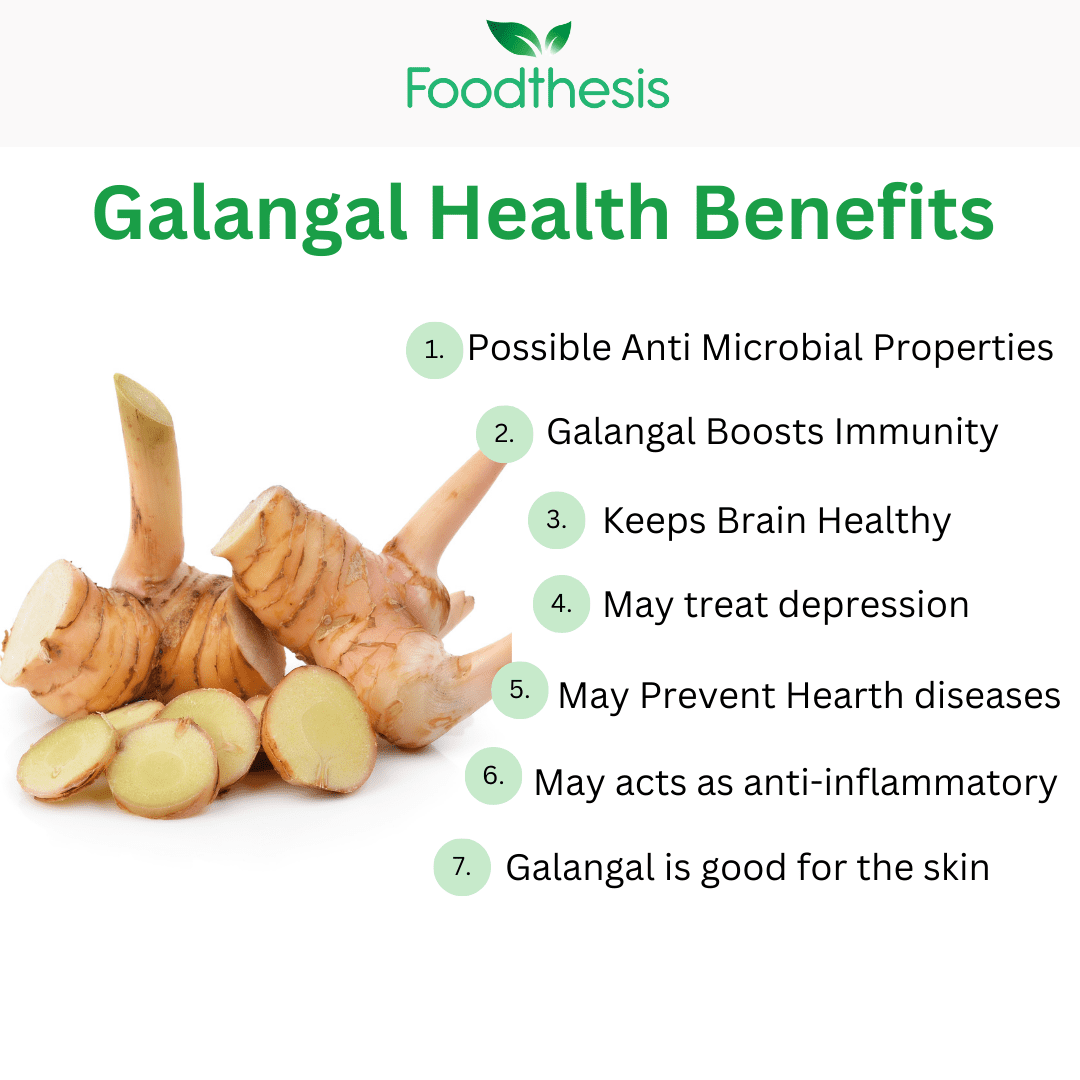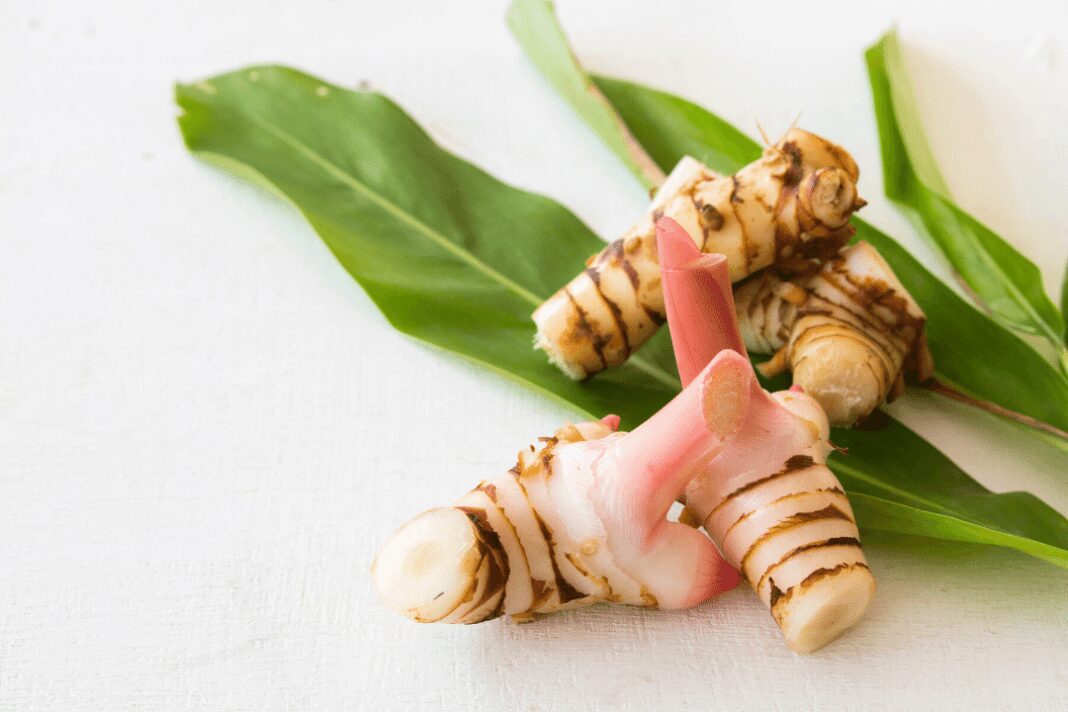Galangal benefits: Quick look
|
Galangal are reddish-brown rhizomes (roots) that have an aromatic spicy flavor and a pungent taste. The galangal benefits are due to the rhizomes. They are being extensively used as a spice or ginger substitute for flavoring food.
It is primarily used in the preparation of fresh Thai curry paste, Thai soup, and in combination with garlic, ginger, chili, and lemon. Also used in traditional Ayurvedic, Unani, Chinese, and Thai medicine for the treatment of various diseases. Galangal health benefits in health are due to its antibacterial, antioxidant, anti-diarrhea, anti-inflammatory, and many other pharmacological properties (1).
Three different varieties of Galangal
1. Lesser galangal (Alpinia officinarum Hance.)
It is a native of southeast China. Its rhizome is smaller, thick, creep, and has a stronger odor and taste.
2. Greater galangal (Alpinia galanga (L.) Willd.)
Commonly found in South East Asia. It is now cultivated throughout tropical and subtropical Asia, such as India, Egypt, Thailand, Malaysia, Indonesia, and China. The rhizome gives a pungent taste like a mixture of pepper and ginger.
3. The light galangal (Alpinia speciosa (Wendl.) K. Schum)
Is a native of the Eastern Archipelago, off the Coromandel Coast of southeast India. Its rhizome is much larger and is generally used as a substitute for greater galanga, and even as a substitute for ginger (2).
Galangal nutritional profile
Greater galangal contains acetoxychavicol acetate (ACA) and hydroxychavicol acetate (HCA). It contains a low amount of fat but a high amount of carbohydrates. Greater galangal is also known to possess flavonoids such as kaempferol, kaempferide, and galangin as well as terpenoids. However, lesser galangal is rich in flavonoids, diarylheptanoids, and essential oils (3).
Galangal Benefits

1. Possible antimicrobial properties of Galangal
The rhizomes of Galangal contain acetoxy chavicol acetate, 5-hydroxymethyl furfural, benzyl alcohol, 1,8 cineole, methyl cinnamate, 3-phenyl-2-butanone, and 1,2 benzene dicarboxylic acid (4).
These compounds help to fight against Bacillus subtilis, Salmonella typhimurium, Enterobacter aerogene, Enterobacter cloacae, Streptococcus epidermis, and Klebsiella pneumonia.
It also inhibits the growth of Escherichia coli, Pseudomonas aeruginosa, Enterococcus faecalis, and Mycobacterium tuberculosis thus possibly making the antibiotic treatment more effective (5, 6).
2. May treat diabetic nephropathy
Poorly controlled diabetes can cause damage to the kidney, heart, gastrointestinal, and urinary bladder. However, galangal contains phenolic and flavonoid compounds that may help to decrease glucose, and urea nitrogen levels in the blood.
It is also effective to increase body weight, good enzymes, and prevent kidney damage. Moreover, these roots are reported beneficial in lowering bad cholesterol and triglyceride levels as well as increasing the good cholesterol level in the blood (7).
3. Galangal boost immunity
It contains a rich amount of flavonoids (quercetin), phenols, glycosides, polysaccharides, and terpenoids. These antioxidants possibly activate the immune response and increase the level of the antioxidant enzyme thus boosting the immune system (8).
4. Keep brain healthy
Galangal contains flavonoids, tannins, and terpenoids that possibly stimulate the central nervous system, enhance mental alertness, and reduce drowsiness and tiredness (9, 10).
Besides this, it also contains acetoxy eugenol acetate that potentially helps in improving memory and concentration and thus may treat Alzheimer’s type of amnesia (11).
Moreover, galangal is may effective in reducing the severity of epileptic seizures, and improving learning disorders, and associated mood disorders (12).
5. May treat giardiasis
Giardiasis is an infection of the small intestine that is caused by the parasite and tends to be higher in HIV-infected persons. These infections have symptoms like abdominal cramps, bloating, nausea, and watery diarrhea. However, the intake of galangal as self-medication by AIDS patients may help to treat this type of infection (13).
6. Galangal benefits for male
Galangal is rich in semi-volatile and volatile compounds such as phenylpropanoids with acetoxy chavicol acetate and pinocembrin. These compounds may help to increase the total number of motile sperm in subfertile men (inability to conceive).
Apart from this, it may help to increase sperm counts and serum testosterone levels and thus may be useful to produce drugs to improve male fertility (14).
7. Potentially have anticancer properties
Research suggested that Acetoxychavicol acetate, 1,7-bis(4-hydroxyphenyl)-1,4,6-heptatrien-3-one (BHPHTO) and bisdemethoxycurcumin (BDMC) found in galangal may act as an antiulcer and antitumor agents (15).
8. May treat inflammation and pain
Ingestion of galangal may help in reducing pain and inflammation in the joints due to the presence of galangin in them (20). Thus galangal may be useful for the treatment of short-term as well as long-term arthritis (21).
9. Antioxidant properties of Galangal
It contains a high amount of antioxidant compounds such as tannins, alkaloids, flavonoids, and saponins. Also, contains phenol and flavonol which scavenge harmful radicals from the body and may protect against various diseases (22).
10. Mosquitoes replant properties
Galangal is rich in terpenoids, flavonoids, and trans-cinnamic acid that can kill Aedes aegypti, Anopheles dirus, and Culex quinquefasciatus larvae (23).
11. May prevent heart disease
Intake of galangal rhizome may help to relax the blood vessels and increase blood supply to the organs. Thus galangal is possibly effective to prevent cardiac contractions and stroke (24).
12. Galangal benefits for skin
The high antioxidant properties of galangal may benefit the skin. The flavonoids of galangal may help in the oxidation or scanavgingthe harmful radicals from the skin.
Side effects of galangal
A research study supported that a high dosage (more than 2000 mg/kg) of galangal may cause weakness, goosebumps, and lack of muscle control or coordination. Moreover, it also causes fear of gaining weight, excessive urination, diarrhea, coma, and even death in animals. Whereas, these side effects of galangal on humans are still needed research (25).
1. Risk of potential organ damage
Galangal consumption in the long term may increase all enzymes (good and bad) which might be toxic to the heart, liver, and kidneys. It also causes contact dermatitis. Thus, some caution should be taken into consideration when using galangal for long periods (26).
2. Possible risk of herpes-associated erythema multiforme
A research study suggested that intake of galangal-containing capsules may cause erythema multiforme. This is a common allergic reaction that occurs in association with the herpes simplex virus and due to the haptens present in galangal thus precaution should be needed before consumption (27).
Q&A
Are turmeric and galangal the same thing?
Turmeric and galangal both belong to the same family Zingiberaceae but galangal has a citrusy, peppery, and sharper taste. Whereas, turmeric rhizome is orange-yellow inside, less aromatic, and slightly bitter than galangal.
Like turmeric, galangal is also used as a flavoring agent and contains various health benefits. Both exhibit antioxidant, anti-inflammatory, and cholesterol-lowering properties but galangal is more valuable in terms of male fertility.
How is galangal different from Ginger?
The inside of ginger is greyish-yellow in color while galangal is the reddish-brown color inside. Moreover, galangal has an earthy, pine-like citrusy flavor, and is more fibrous, and woody in texture. On the other hand, ginger is fresh, juicy, spicy as well as sweet in taste with less fibrous and woody than galangal. However, both are useful for the treatment of cancer such as leukemia cancer (28).
What is galangal called in English?
Galangal is available in three types lesser galangal, greater galangal, and light galangal known in English.
What can I use instead of galangal?
Ginger can be used in place of galangal but it did not give the same flavor as galangal.
